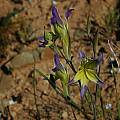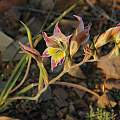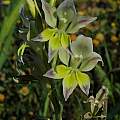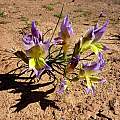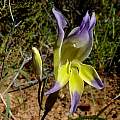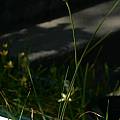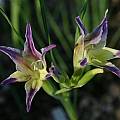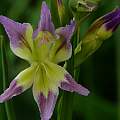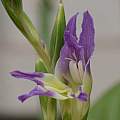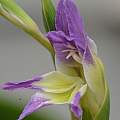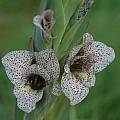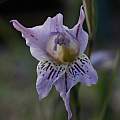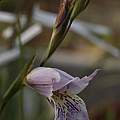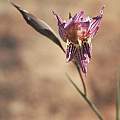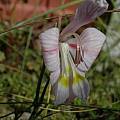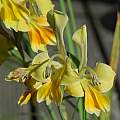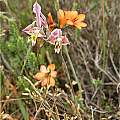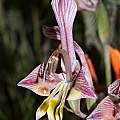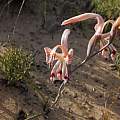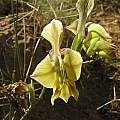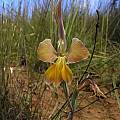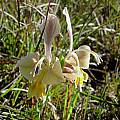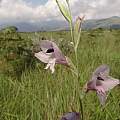There are about 163 species of Gladiolus (with new ones being discovered) in the area south of the Tropic of Capricorn and including Botswana, Lesotho, Namibia, South Africa, Swaziland, and Mozambique. Some are found in winter rainfall areas and some in summer rainfall areas. For more information see Goldblatt and Manning, 1998. Southern African species from U-Z are pictured on this page.
Gladiolus index - Southern African gladiolus A-B - Southern African gladiolus Ca - Southern African gladiolus Ce-E - Southern African gladiolus F-H - Southern African gladiolus I-Me - Southern African gladiolus Mi-Pa - Southern African gladiolus Pe-R - Southern African gladiolus S-T - Gladiolus Hybrids - Miscellaneous gladiolus
Gladiolus undulatus L. is a late spring summer flowering plant found on marshy sandstone slopes in the northwest and southwest Cape. It has whitish to cream flowers with pink diamonds on the lower tepals. Plant height: 45-150 cm. Although it is similar to Gladiolus carneus, it has a much longer tube with wavy tepals. Given the right conditions in some areas outside of South Africa this species has naturalized. The first three photos were taken by Mary Sue Ittner of flowers blooming various years in June in northern California. Photos 4-5 were taken in habitat by Andrew Harvie near Bainskloof. The last photo was taken by Rod Saunders.
Gladiolus uysiae L.Bolus ex G.J.Lewis is brownish purple with dark veining and fragrant. It flowers late winter to early spring and can be found on clay slopes in renosterveld. Height: 7-15 cm. Photos 1-4 were taken in habitat near Middelpos in the Roggeveld by Mary Sue Ittner, Bob Rutemoeller and Cameron McMaster.
The first three photos were taken by Alan Horstmann in 2023 near Middelpos. The fourth photo was taken by Cameron McMaster near Nieuwoudtville September 2011. The last photo taken by Bob Rutemoeller shows one grown by Gordon Summerfield in South Africa flowering September 2003.
Gladiolus vaginatus F.Bolus grows on limestone and clay loam slopes in fynbos and renosterveld from the Cape Peninsula to Caledon and Knysna. It has blue to gray flowers with dark streaks on the lower tepals and blooms late summer to fall. It is similar to Gladiolus exilis and Gladiolus mutabilis, but only has two leaves with lack blades. Height range: 30-50 cm. Photos taken near Napier by Cameron McMaster in the Overberg.
Gladiolus vandermerwei (L.Bolus) Goldblatt & M.P.de Vos, syn. Antholyza vandermerwei L.Bolus, syn. Homoglossum vandermerwei (L.Bolus) L.Bolus , has a narrow distribution in the central part of the western Cape where it is found on shale slopes in renosterveld in dry habitats. It has bright red flowers with an elongated perianth tube. The lower tepals are short and narrow, yellowish in the lower half and arch outward. Height range: 30-60 cm. Photos were taken near Bredasdorp in the Overberg by Cameron McMaster in September in different years.
Gladiolus venustus G.J.Lewis has flowers that are shades of purple to pink and sometimes dull yellow with yellow markings on the lower half of the lower tepals. It is widely distributed across the interior of the winter rainfall areas of southern Africa where it is found in dry habitats on clay and sandstone slopes. The primary pollinators are long tongued bees. It can be confused with Gladiolus scullyi and it has been included in that species at one time but it usually more colorful than that species which is usually greenish cream to yellow brown or beige and more highly scented. The dorsal tepal on Gladiolus scullyi is also more horizontal, inclined over the stamens and the upper two lateral tepals curve outward in an arc. But the distinctions are sometimes difficult to tell, especially in areas where they both grow. An example of this difficulty is shown in the third picture which I suppose could be either species. Height range: 12-35 cm. The first two photos by Mary Sue Ittner and Bob Rutemoeller were taken September 2006 in the Roggeveld. The third photo from Mary Sue Ittner was taken near Nieuwoudtville. The last two photos were taken by Cameron McMaster September 2011 near Middelpos in the Roggeveld.
Photos below were taken by Bob Werra.
Photos below were taken by Arnold Trachtenberg.
Gladiolus vernus Obermeyer grows in rocky grassland in the Blyde River Canyon area in Mpumalanga. It flowers in July and August in completely dry conditions before the first rain starts. Foliage leaves are produced afterwards in September or October. Flowers are pale to deep pink, or cream, with the upper tepals darker above and with a yellow zone on one or all of the three lower tepals. This zone is sometimes edged with dark pink or purple. The lower halves of the lower tepals are speckled with pink. Flowers are unscented and plants grow from 45 to 75 cm high. Photo from Rachel Saunders.
Gladiolus vinosomaculatus Kies grows in exposed and often dry sites (rocky hilltops and slopes in short grassland) and on rocky outcrops in the summer rainfall areas of southern Africa north of the Vaal River. The tepals are covered with large purple to reddish spots on a pale background. The leaves have long sheaths that form a short pseudostem. Height: 65 cm. This species is closely related to Gladiolus ecklonii. Photo taken by Rod Saunders.
Gladiolus violaceolineatus G.J.Lewis grows in the Cedarberg Mountains, where it is generally found on south-facing sandstone slopes that remain moist throughout the winter, according to Goldblatt & Manning. The flower is pale violet with dark purple lines on the tepals, which are often narrower and longer than shown in these photos. The flowers are sweet-smelling, and reportedly bloom in early spring, although they may bloom a bit later at higher elevations. Height range: 35-60 cm. The first two photos by Michael Mace. The last photo from Rod Saunders.
Gladiolus virescens Thunb. grows on sandstone or clay slopes in a broad area flowering in late winter to spring. Flowers are yellow to pink with dark veins and very fragrant. Height range: 10-25 cm. The first photo shows a pink one grown by Alan Horstmann and photographed by Bob Rutemoeller. The next two photos were taken by Mary Sue Ittner of plants grown from seed. Photos 4 and 5 were taken by Andrew Harvie at the De Hoop Nature Reserve. The last photo was taken by Rachel Saunders of an unusual color form found flowering in December, much later than the usual time.
Two different color forms were photographed in the southwest Cape September 2003 by Bob Rutemoeller. The next three photos were taken by Cameron McMaster at Boskloof and near Napier, both in the Overberg. The last picture shows the seed pods.
Gladiolus virgatus Goldblatt & Manning is restricted to cool, well watered slopes of the coastal ranges of the southwestern Cape. Poorly collected, it has been found in clay soil on ground covered with scattered sandstone boulders. Growing from 30 to 60 cm high, it has linear leaves with slightly thickened margins and midribs. The pale to deep pink or nearly white large unscented flowers are marked on the lower tepals with a spear shaped whitish median streak edged with a reddish v shaped mark, speckled in the throat and are in a two to four flowered inclined spike. The dorsal tepal is inclined over the stamens. This species flowers September-November. The first two photos from Rachel Saunders taken in the Helderberg Nature Reserve. The next three photos from iNaturalist taken by linkie in the same place in November and shared under a CC BY-NC license.
Gladiolus viridiflorus G.J.Lewis grows on rocky sandstone slopes in the northwest Cape. The first photo was taken by Sheila Burrow of a plant flowering exactly one year from sowing. The second photo from Rachel Saunders was taken near the Pakhuis Pass. Although it grows in many areas, it is small (10-20 cm) and difficult to see and not very common.
Gladiolus watermeyeri L.Bolus grows on rocky sandstone slopes in the Northwest Cape, and has a height range of 10-30 cm. It is very fragrant and we could smell the one growing near Nieuwoudtville in the first photo from Mary Sue Ittner before we saw it. Photo 2 was taken by Rod Saunders. Photos 3-4 from Cameron McMaster were also taken near Nieuwoudtville.
Gladiolus watsonius Thunb. has had multiple names over the years. It has been included in Watsonia, Homoglossum and Antholyza before settling in Gladiolus. It is found on clay and granite slopes in renosterveld in the northwest and southwest Cape. It blooms in late winter, early spring with an erect spike of red to orange flowers. Height range: 30-70 cm. The first photo below was taken by Bob Werra and the second by Susan Hayek in the greenhouse of Diana Chapman. Photos three to five by Mary Sue Ittner of plants at Telos and plants blooming in her garden in February 2007. The sixth photo was taken by Alan Horstmann.
The photo below shows some dormant corms. The tunics can sometimes have a papery outer layer, as shown by the larger corm on top. But the two smaller corms at center show the "teeth" at the bottom of the tunic that are typical for this species. Photo by Michael Mace.
Gladiolus wilsonii (Baker) Goldblatt & J.C.Manning grows in the Eastern Cape which is a summer rainfall area, but it flowers in spring with the leaves (October to November) after scant autumn and winter rainfall. It grows in open grassland in light loamy sand. It has short tubed white to cream fragrant flowers. Sometimes the reverse of the upper tepals is flushed pink to purple toward the tips and sometimes the lower three tepals have a short pale mauve streak near the base. Height range: 20-40 cm. The first two photos by Cameron McMaster. The last three photos were taken January 2010 near Maclear in the Eastern Cape by Bob Rutemoeller and Mary Sue Ittner. Originally identified as Gladiolus inandensis which is very similar, it has now been identified as this species since the other species flowers July into August and flowers with the dry leaves from the previous season.
Gladiolus woodii Baker grows in grassland, on rocky hillsides from 800 to 2000 m in the summer rainfall area of South Africa from KwaZulu-Natal to the Limpopo Province. Mostly found in high elevation and high rainfall areas, it flowers early in the season, soon after it rains (from September to December). Leaves are often short and sheath the stem. Flowers are variable in color, pale yellow or lilac, oyster colored, dark maroon or red-brown with or without a longitudinal dark brown to purple stripe along the midline of the lower tepals and faintly to not scented. The upper tepals are much larger than the lower tepals and the lower laterals are folded. Height range: 20-45 cm. Photo from Rod Saunders.
Gladiolus index - Southern African gladiolus A-B - Southern African gladiolus Ca - Southern African gladiolus Ce-E - Southern African gladiolus F-H - Southern African gladiolus I-Me - Southern African gladiolus Mi-Pa - Southern African gladiolus Pe-R - Southern African gladiolus S-T - Gladiolus Hybrids - Miscellaneous gladiolus





















